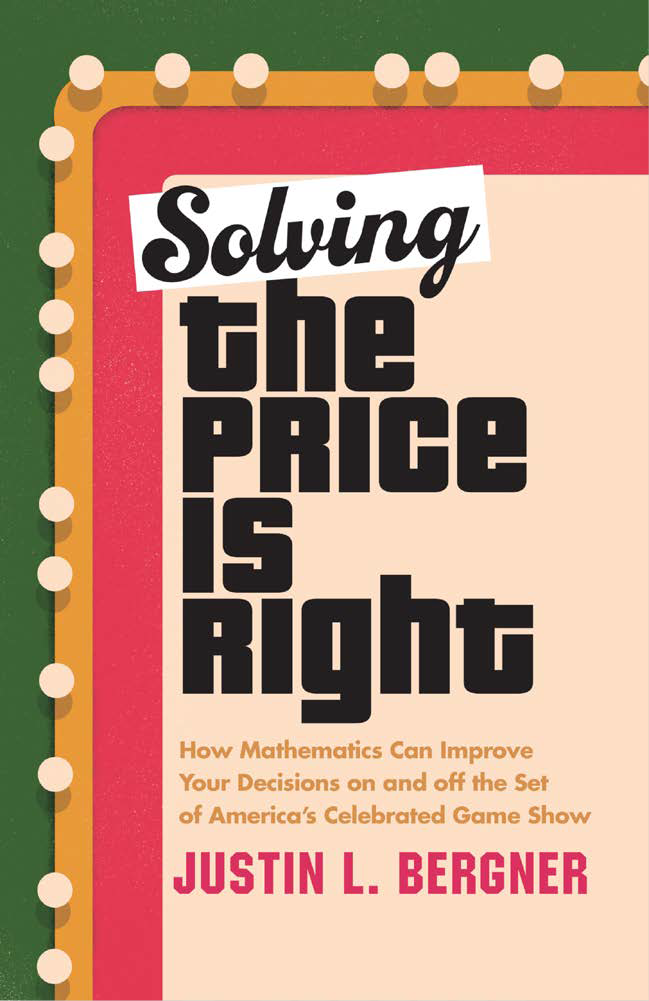
Solving The Price Is Right by Justin L. Bergner. Prometheus Books, $29.95.
The opening camera shot is a corny classic: The packed studio, the frenzied crowd leaping out of their seats — and the announcer who summons one lucky, delighted audience member with a booming, “Come on down!”
That clarion call lurks in the consciousness of countless Americans, especially fans of The Price Is Right. And investment analyst and consultant Justin L. Bergner is definitely a devotee of the classic game show, with endless curiosity about what really makes it tick. He’s channeled that passion into Solving The Price Is Right, a book-length dive into the quantitative (and qualitative) game theory that hums in the background of the game’s whiz-bang action.
Since 1972, The Price Is Right (henceforth TPIR) has plunged contestants with wild t-shirts and even wilder energy into a whirlwind of guessing games, culminating in a grand Showcase Showdown. From the days of legendary presenter Bob Barker through today’s version hosted by Drew Carey, the show’s roller-coaster vibe revolves around a simple basic premise: Guess the correct prices of select items as closely as you can without going over.
That’s the essential skill in the initial Contestant’s Row round, where players vie to be the best guesser who moves on to the next phases of play. Whoever survives the round then plays a new game picked from the 77 pricing games in the show’s repertory — Bargain Game, Switcheroo, Do The Math, Gas Money and Bullseye, to name a few. After the 77th pricing-game, the process repeats. Another audience member is called to Contestant’s Row, another guessing round is played, another Row winner goes on to another pricing game. After three contestants make it out of Contestant’s Row and play their pricing games, they take turns spinning the Big Wheel to determine which of them goes on to the show’s crowning moment, the final Showcase round with its prize haul worth tens of thousands of dollars.
For viewers at home, TPIR’s action goes by in a neon-tinted flash, punctuated by the occasional contestant freak-out and Drew Carey’s wry asides. But there’s nuance under the razzle dazzle. TPIR isn’t like Jeopardy! or even Wheel of Fortune, where the stakes change from round to round, but the essential play remains the same. In TPIR, each phase — Contestant’s Row, the pricing game, the Big Wheel, the Showcase — forms its own little gaming universe, complete with potential strategies and perennial contestant miscalculations.
This complexity might elude even mega-fans who trek to the show’s LA studio for a taping, but not Bergner. It takes a rare determination to parse two seasons (356 episodes) of TPIR in their entirety, analyzing which games are played with which frequency, which games tend to produce the highest and lowest payouts, and which techniques are statistically indicated to increase the chances of becoming a big winner. Fortunately, Bergner has the grit (and face it, the obsessiveness) for the job.
For starters, he names “seven psychological suppositions” that make and break game play in TPIR. These include widespread underbidding bias (especially in Contestant’s Row); “anchoring,” in which players instinctively clump their guesses together at comparable values; and a restless tendency to rush one’s moves in games where the price rises bit by bit to a target range. Some of this behavior is emotion-driven — contestants tend to bid too cautiously on unfamiliar items such as jukeboxes, for example. But a simplified game theoretic model could help players in Contestant’s Row bid more rationally, to “maximize [their] share of the portion of the number line over the lowest bid,” thus increasing their chances of a win. (The short version: In Contestant’s Row, the first bidder should guess as high as they dare, the middle two should guess reasonably high but not over Bidder 1; and the fourth and last bidder should “clip” the highest existing bid by betting $1 more.)
Bergner broadens his approach by suggesting ways in which TPIR and its underlying strategies can apply to non-game-show situations. For example, the chronic tendency to bid too low on prize items reveals how strongly consumers are conditioned to below-list prices; it also underscores how useful it is for a TPIR contestant to know suggested retail costs. Some examples do seem a little forced, as when Bergner tries to draw a parallel between the anchoring phenomenon in Contestants’ Row and best practices for college applicants or political candidates: “Differentiate your bid with a differentiated pitch.” But in general, these forays into applied economics are fun and thought-provoking.
All that said, Solving The Price Is Right isn’t quite a layman’s book. To truly geek out on Bergner’s analysis requires a practiced ease with the game-theory models that drive his points home. (Even famous probability teasers like the Monty Hall problem could be a reach for the casual reader, at least until they Google it.) On the other hand, Solving The Price Is Right may well hit the spot as an entertaining supplemental read for an undergraduate statistics course. Put it on the syllabus along with some mandatory viewing of Drew Carey’s sitcom or improv comedy show — and who knows, you might end up with everyone’s favorite math elective on your hands.
Liz Haigney Lynch is a genealogist, editor and writer whose work has appeared in the Miami Herald, the Sun-Sentinel of Fort Lauderdale, and the Chicago Sun-Times.













